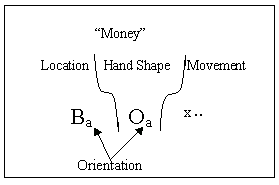Two Notation Systems for Signed Languages: Stokoe Notation & Sutton SignWriting Joe Martin Western Washington University Martinj4@cc.wwu.edu |
||||||||||||
|
STRUCTURE continued... Ordering
SN clings to the traditional idea of the "linear ordering
of the speech signal." It arranges its symbols according
to a strict formula: the Location symbol is first, followed by
the Hand Shape, and lastly the Movement. Movement symbols stacked
vertically signify simultaneous This ordering scheme was chosen for economy; like the decimal numbering system, it allows the same symbol to do different tasks. A "B-hand" can stand for a Location (initial position) or for a Hand Shape (center position) depending on its position in the formula. On the other hand, this imposes an artificial relationship on the symbols, that of linear ordering. As Stokoe says, "This order corresponds to no sequence in sign phenomena; it is arbitrary" (Stokoe 1960, 40). However arbitrary, it arises from the traditional view of language as linear segments. Once freed from this artificial constraint, it seems curious to draw two items in the wrong place, and then invent a new symbol to tell how they were arranged to begin with. SN Symbol Ordering  SSW organizes these elements spatially and simultaneously, as they actually occur. The SSW character is not a description of the sign, but an actual map showing the positions of the articulators. The center of the map, the reference point, is the center of the signing space. Unselected articulators, those not involved in making the sign, can be left out if desired, but all selected articulators are shown, together with the spatial relationships amongst them. This is why there is no need for a separate Location symbol. All the parameters, except Movement, can be treated as spatial relationships among the various articulators. The parameter called Location is the relationship of the Hand Shape to the body, the head and the other articulators. Hand Shape itself is no more than the location of (i.e. the relationship among) the fingers, thumb and palm. The parameter of Facial Expression consists of the relationships amongst the brows, lips and other parts of the face. Just like describing a hike through the mountains, there is no question that a map is the best way to represent relationships in space. If the articulators of speech weren't hidden away where we can't see them, it is likely we would use this method for speech too, instead of relying on the secondary information provided by sound waves.
|
||||||||||||
|
|
